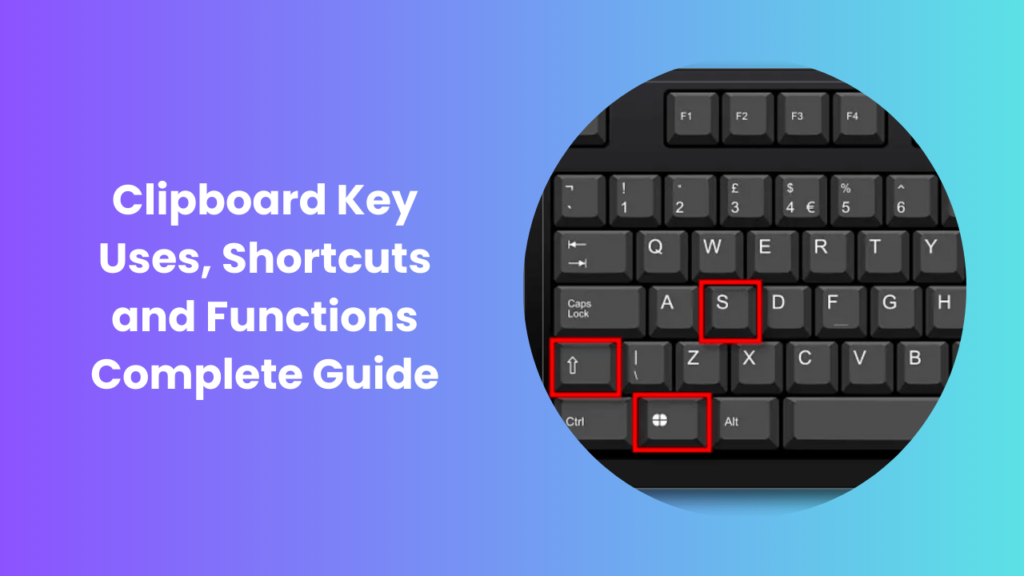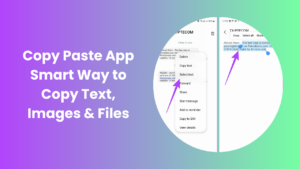In the world of modern technology, even the smallest tools can shape the way we work, study, or communicate. Among these often-overlooked yet highly impactful tools is the clipboard key, a function that serves as a bridge between what we copy and how we paste it into our tasks. The importance of this feature becomes clearer when we consider how much of our digital routine depends on copying and pasting. Without an efficient clipboard system, we would be stuck rewriting the same information multiple times or switching back and forth between programs.
Think about how often students copy text from research materials, or how employees transfer data between spreadsheets, or how developers move snippets of code between files. Each of these seemingly small actions is powered by the clipboard. Without it, our digital tasks would not only take longer but would also be far more error-prone.
What is the Clipboard in Computing?
The clipboard itself is a temporary storage space within an operating system. It holds any data that a user cuts or copies until that data is replaced or pasted into another program. This simple process has existed for decades and is a cornerstone of digital workflows. Every major operating system, from Windows to macOS and Android, incorporates some form of clipboard functionality because it is so vital for productivity.
When you copy a sentence from a webpage or cut a file to move it into another folder, the clipboard silently handles the task in the background. The beauty of the feature is that it requires no special setup, and yet it saves countless hours for users across all industries. It may not have the flashy interface of a major app, but its impact is felt every time we use our devices.
Evolution of Clipboard Shortcuts
In the early days of computing, the clipboard could only store a single piece of information. Once something new was copied, the old content vanished. While this was enough for basic editing, it was not practical for users who needed to reuse multiple pieces of information. Over the years, operating systems introduced clipboard history, synchronization, and even cloud-based storage, transforming a simple feature into an advanced productivity tool.
Today, features like pinned items, cross-device access, and integration with advanced text editors have become standard. This evolution shows that even small system functions can grow to meet the demands of modern workflows. It also highlights how users need to drive technological progress, turning a once-simple memory buffer into a multi-functional assistant.
Understanding the Clipboard Keys in Modern Use
The keys acts as a gateway to quickly access clipboard functions without relying solely on standard shortcuts. On Windows devices, the Windows + V shortcut is considered the key to clipboard history, while many smartphone keyboards provide an on-screen clipboard button. This addition saves time, reduces unnecessary clicks, and keeps productivity high by offering a direct path to previously copied items.
Consider a scenario where a business analyst is working on a detailed report and needs to reference statistics from multiple sources. With the keys, they can easily pull up previous copies without switching between tabs repeatedly. In another example, a social media manager scheduling posts can reuse captions, hashtags, and links instantly from clipboard history. These practical applications demonstrate why having a direct key for clipboard access is more than just a convenience it is a real productivity booster.
Benefits of Using Clipboard Functions
Clipboard functions are used by almost everyone, even if they don’t realize it. Writers depend on them to rearrange content, researchers use them to store notes, and designers copy assets across projects. By making copying and pasting effortless, the clipboard enhances focus and reduces interruptions. For people who manage multiple projects or handle repetitive data, it is an essential tool.
The psychological benefit of reduced task-switching is also significant. Constantly moving back and forth between files or retyping information breaks concentration. By minimizing this disruption, clipboard functions not only save time but also improve focus and creativity. When tasks flow naturally, people are more likely to stay in a productive state of mind.
Key in Windows Systems
Windows has long integrated clipboard features into its environment. By enabling clipboard history, users can access previously copied items and even pin the ones they use most frequently. This feature prevents frustration caused by losing information when copying something new. For professionals working with large amounts of text or data, the keys acts as a safeguard that ensures important material never gets lost.
The system also allows synchronization across devices when linked to a Microsoft account. This means something copied on a laptop can later be pasted on a desktop or even a tablet. Such integration reflects the way people now work across multiple devices daily and highlights how deeply the clipboard has become embedded in everyday digital life.
Key on Mobile Devices
On mobile platforms, virtual keyboards like Gboard and SwiftKey often include a clipboard button. This key makes it simple to retrieve recent copied items, whether they are text messages, links, or images. Cloud sync has taken this even further by allowing copied content on one device to appear instantly on another, creating a smooth workflow across phones, tablets, and computers.
Mobile use of the clipboard is particularly important because of how much time people spend on their phones. Messaging, emailing, browsing, and social media all rely heavily on sharing content. The clipboard ensures this process remains effortless, allowing people to stay connected without wasting time repeating tasks.
Security and Privacy Concerns
While the clipboard is convenient, it can also store sensitive data. This makes it important for users to manage what stays in clipboard history. Modern systems restrict apps from freely accessing clipboard data, but users should still practice caution when copying passwords or financial details. Regularly clearing the clipboard and turning off history on shared devices are smart ways to stay safe.
Developers and IT professionals also encourage users to be mindful of third-party clipboard managers. While these tools add functionality, they may collect data in ways that compromise privacy. Choosing trusted software and enabling only the features you truly need ensures that the clipboard remains an ally rather than a security risk.
Future of Clipboard Technology
The clipboard is evolving beyond its traditional role. Developers are experimenting with intelligent clipboards that automatically organize data, suggest relevant past items, or adapt to the type of content being copied. In the future, AI-powered clipboards may offer features like real-time translation, contextual formatting, or predictive pasting. This progression ensures that the keys will remain relevant as computing continues to advance.
Future possibilities could also include integration with voice commands, allowing users to retrieve clipboard history simply by asking their virtual assistant. For professionals in fast-paced industries, this would mean accessing critical data without even touching the keyboard. Such innovations are likely to make the clipboard more intuitive, adaptive, and indispensable.
Additional Related Headings
Clipboard History vs Keys
Although closely related, clipboard history and the keys are not identical. Clipboard history refers to the stored list of items a user has copied, while the key is the function or shortcut that opens this list. Without the key, users would need to rely on single-copy functionality, which limits efficiency. The combination of the two gives users both power and convenience.
Common Misconceptions About Clipboard Use
Many people assume the clipboard is unlimited, but in reality, its capacity is often restricted by system settings. Others believe copied content stays forever, when in fact most systems automatically clear clipboard data after a reboot for security reasons. Understanding these limitations helps users avoid confusion and make the most of clipboard functions.
The Role of Third-Party Clipboard Managers
Beyond built-in features, third-party applications expand what the clipboard can do. These managers allow users to categorize, label, and search their copied content. They can even store thousands of items, making them popular among developers, researchers, and content creators. While these tools offer advanced features, they rely on the same basic principles that make the clipboard indispensable.
FAQs
How can I enable clipboard history in Windows?
You can enable clipboard history by opening system settings, navigating to the clipboard section, and turning on the history option. Once it is active, pressing Windows + V will bring up the panel of previously copied items.
Can I access my clipboard across devices?
Yes, with features like cloud sync, clipboard data can move across multiple devices. Windows accounts and mobile apps make this process seamless. For example, you might copy an address on your phone and paste it into a document on your computer moments later, making your workflow more unified.
Is the clipboard secure?
Clipboard content is temporary, but it can hold sensitive information. Clearing clipboard history regularly and being mindful of what you copy are the best ways to keep data secure.
What are common problems with clipboard use?
Clipboard issues often occur when history is disabled or corrupted. Restarting the system or resetting clipboard settings typically resolves these problems. On mobile devices, issues may arise when the keyboard app is outdated, so keeping software updated is a simple way to prevent disruptions.
Can I customize the clipboard?
Yes, with third-party tools, you can create custom clipboard workflows. These tools make it possible to save more items, apply formatting automatically, or even automate repetitive tasks.
Conclusion
The clipboard key might appear to be a minor feature, but its role in digital productivity is far greater than it seems. By giving users immediate access to stored information, it eliminates wasted time and streamlines the movement of data across applications and devices. With innovations such as clipboard history, synchronization, and AI-driven enhancements, its usefulness will only continue to grow.
The future of the clipboard is not just about storage it is about intelligence and adaptability. As developers refine its capabilities, the clipboard will become smarter, faster, and even more integrated into daily workflows. For anyone who relies on digital tools, from office workers to students and content creators, mastering this function is an easy step toward higher efficiency.





